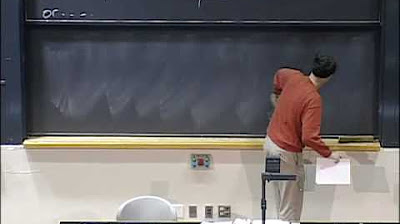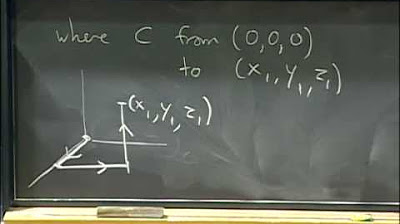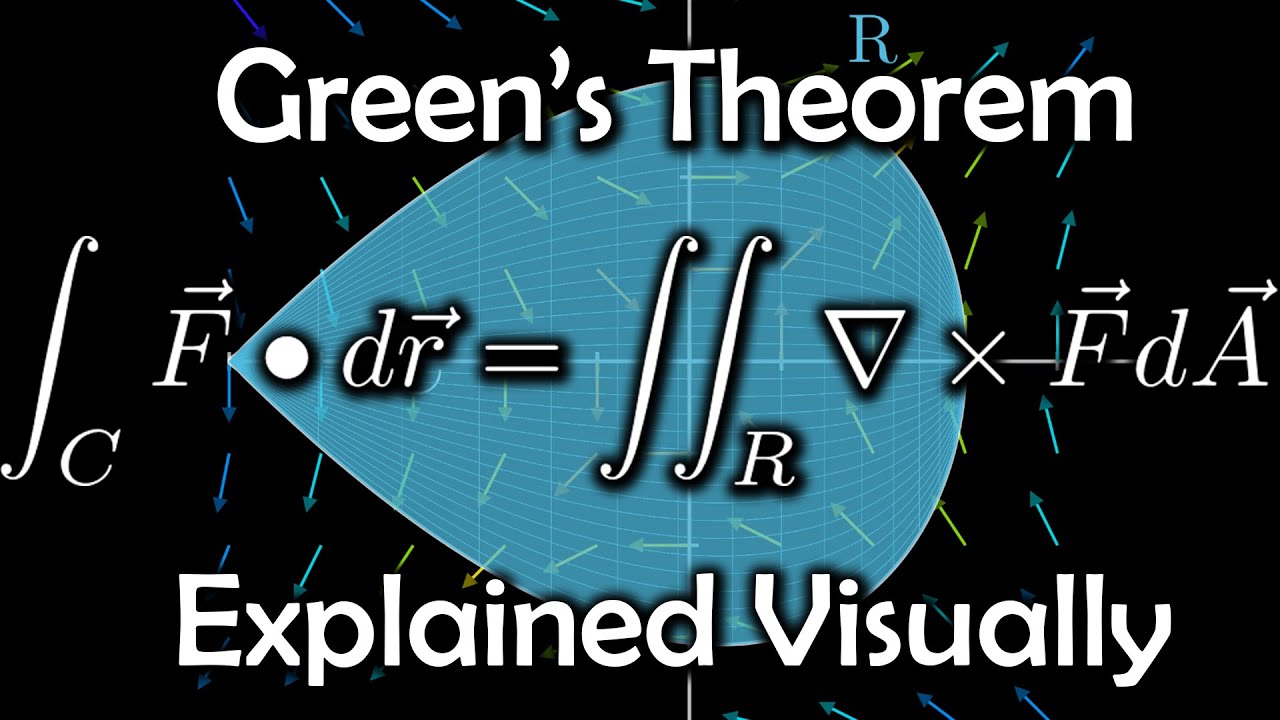Lec 24: Simply connected regions; review | MIT 18.02 Multivariable Calculus, Fall 2007
TLDRThis lecture delves into the nuances of vector calculus, focusing on the concepts of curl, conservative vector fields, and Green's theorem. It clarifies the conditions for a field to be conservative, emphasizing the importance of the vector field's definition across the region. The lecture also explores the validity of Green's theorem in relation to simply connected regions and introduces the idea of extending the theorem for regions with holes. Additionally, it covers the setup and evaluation of double and line integrals, including the application of Green's theorem for work and flux, and the use of potential functions in line integrals. The summary also touches on the importance of understanding the geometric interpretation and computational methods for integrals, setting up the stage for problem-solving in multivariable calculus.
Takeaways
- 📚 The lecture discusses the importance of MIT OpenCourseWare and the need for donations to continue offering free educational resources.
- 🔍 It clarifies the difference between a vector field having a curl of zero and the field being a gradient field, emphasizing the need for the field to be defined everywhere for certain theorems to apply.
- 📈 The significance of Green's theorem is highlighted, explaining its two forms related to line integrals and double integrals, and the conditions required for their validity.
- 🌀 The concept of curl being zero and its implications for the conservative nature of a vector field within a simply connected region is explored.
- 📉 An example is provided where a vector field is not defined at the origin, illustrating the limitations of applying Green's theorem in such cases.
- 🔄 An extended version of Green's theorem is introduced, allowing for the application of the theorem in regions enclosed by two different curves.
- 📐 The lecture touches on the topic of topology, particularly the concepts of connected and simply connected regions, and their relevance to vector field analysis.
- 📝 The importance of setting up and evaluating double integrals and line integrals is stressed, with examples provided to illustrate the process.
- 📉 The use of polar coordinates for double integrals is discussed, along with the formulas for computing quantities like area, mass, average value, and moments of inertia.
- 🔢 Various integration techniques are mentioned, including substitution and easy trigonometry, with a focus on the methods needed for evaluating integrals in the exam.
- 🛠 The process of changing variables in double integrals is explained, including finding the Jacobian, substituting the integrand, and setting new bounds for the integration.
Q & A
What is the main purpose of the MIT OpenCourseWare initiative mentioned in the script?
-The main purpose of the MIT OpenCourseWare initiative is to offer high-quality educational resources for free, supported by donations, allowing access to materials from hundreds of MIT courses.
What is the fundamental difference between a vector field having a curl of zero and it being a gradient field?
-A vector field having a curl of zero indicates that it has the potential to be conservative, but it is only a gradient field if it meets additional criteria such as being defined in a simply connected domain.
Why is it necessary for a vector field to be defined everywhere inside a region for Green's theorem to apply?
-For Green's theorem to apply, the vector field must be defined everywhere inside the region because the theorem involves a double integral over the enclosed region, which requires the field to be well-defined throughout that area.
Can Green's theorem be applied to a region with holes, and if so, under what conditions?
-Yes, an extended version of Green's theorem can be applied to regions with holes by considering the line integrals over multiple curves that bound the region, ensuring that the outer boundary is traversed counterclockwise and the inner boundaries are traversed clockwise or accounted for with a minus sign.
What is the significance of a region being simply connected in the context of vector fields and Green's theorem?
-A simply connected region is one that does not have any holes inside it. If a vector field is defined and differentiable in a simply connected region, Green's theorem can be applied without concerns about the field being undefined at certain points, such as the origin.
What is the correct statement regarding a vector field being conservative if its curl is zero?
-If the curl of a vector field is zero and the domain of definition where the field is defined is simply connected, then the vector field is conservative, meaning it is a gradient field.
What are the two main formulas or concepts associated with double integrals in the script?
-The two main concepts are setting up double integrals for regions involving quantities like area, mass, average value of a function, and moments of inertia, and evaluating these integrals using appropriate techniques.
How does one set up a double integral in polar coordinates?
-In polar coordinates, one must remember that x becomes r cosine theta, y becomes r sine theta, and the area element dx dy becomes r dr d theta. The integration is typically done first over r for a fixed theta, determining the range of r values within the region for each theta.
What is the fundamental theorem of calculus for line integrals when dealing with gradient fields?
-The fundamental theorem of calculus for line integrals states that if the line integral is of a gradient field, the work done is equal to the change in the potential function evaluated at the endpoint minus the starting point.
What are the two forms of Green's theorem mentioned in the script, and how do they relate to line and double integrals?
-The two forms of Green's theorem relate the line integral of a vector field around a closed curve to a double integral over the enclosed region. One form equates the line integral to the double integral of the curl of the field, and the other equates the total flux to the double integral of the divergence of the field.
What is the importance of parameterizing a curve in line integrals, and how does it simplify the process?
-Parameterizing a curve in line integrals is crucial as it reduces the integral to a single variable, allowing the expression of x and y in terms of that parameter, which simplifies the computation of the integral.
Outlines
📚 Introduction to MIT OpenCourseWare and Conservative Vector Fields
The script begins by acknowledging the support of the audience, which helps MIT OpenCourseWare provide educational resources for free. It then delves into a discussion about the distinction between a vector field having zero curl and it being a gradient field. The lecturer emphasizes the importance of the vector field being defined everywhere for the field with zero curl to be conservative. The validity of Green's theorem is also discussed, highlighting the need for the vector field to be defined over the entire region for the theorem's application in comparing line integrals along a closed curve to double integrals over the enclosed region.
🔍 Detailed Explanation of Green's Theorem and Its Limitations
This paragraph explores the two forms of Green's theorem, which relate the line integral of a vector field along a closed curve to the double integral over the enclosed region. It clarifies that for the theorem to hold, the vector field must be defined everywhere within the region. The lecturer provides an example of a vector field that is undefined at the origin, which affects the application of Green's theorem. An extended version of the theorem is introduced to handle regions with holes by considering the line integral between two different curves, which is equal to the double integral over the region between them.
🔄 Application of Green's Theorem in Multiply Connected Domains
The discussion continues with the application of Green's theorem in regions with multiple boundary curves. It is explained that the theorem can be applied as long as the outer boundary is traversed counterclockwise and the inner boundaries are either traversed clockwise or have a minus sign applied. The lecturer also touches on the concept of simply connected regions, which do not have holes, and how Green's theorem can be applied without concern for enclosed curves within such regions.
📘 Clarification on Conservative Vector Fields and Simply Connected Domains
The lecturer clarifies the conditions under which a vector field with zero curl is conservative, specifically when it is defined in a simply connected region. The importance of the domain of definition for the application of Green's theorem is reiterated, with an example of a vector field that is not simply connected due to the exclusion of the origin. The correct statement is presented: if a vector field is defined in a simply connected region and its curl is zero, then it is a gradient field.
📝 Review of Exam Topics and Importance of Double and Line Integrals
The script shifts focus to reviewing for an upcoming exam, emphasizing the importance of understanding how to set up and evaluate double and line integrals. The lecturer lists the main topics to be aware of, including the setup of double integrals in different coordinate systems and the application of Green's theorem. The review also includes a brief mention of the divergence theorem and the concept of simply connected regions in the context of topology.
📐 Techniques for Setting Up and Evaluating Double Integrals
This paragraph provides a detailed explanation of how to set up double integrals, including drawing the region of integration, choosing the order of integration, and carefully setting the bounds. The importance of understanding the region and being able to set up the integral accordingly is stressed. Examples are given to illustrate the process of exchanging the order of integration and the need to consider different cases based on the region's shape.
📉 Understanding Polar Coordinates and Double Integral Applications
The lecturer discusses the use of polar coordinates for double integrals, explaining the conversion from Cartesian coordinates to polar coordinates and the associated change in the integral's differential elements. Applications of double integrals are also summarized, such as calculating the area of a region, mass with a given density, average values of functions, and moments of inertia. The importance of remembering these formulas for the exam is highlighted.
🧭 Strategies for Integration and Partial Credit on Exams
The script provides guidance on the types of integration techniques that students should be familiar with for the exam, including basic integration of functions like exponentials, trigonometric functions, and inverse trigonometric functions. The lecturer advises students on what to do if they encounter a difficult integral or forget a formula, emphasizing that partial credit can be earned for setting up the integral correctly, even if the final evaluation is not completed.
🌀 Advanced Integration Techniques and Change of Variables
This paragraph delves into more advanced integration techniques, such as change of variables and Jacobian matrices. The three-step method for changing variables in a double integral is outlined, including finding the Jacobian, substituting the integrand with the new variables, and setting up the new bounds for integration. The importance of simplifying the integral through a change of variables is emphasized, and examples from practice exams are mentioned to illustrate the application of these techniques.
🛠 Computation of Line Integrals and Work
The final paragraph focuses on the computation of line integrals, particularly for work, and the conditions under which a vector field can be considered a gradient field. The fundamental theorem of calculus for line integrals is discussed, which allows for the simplification of the line integral computation when the field is conservative. The difference between line integrals for work and flux is highlighted, and the application of Green's theorem to compute line integrals along closed curves is summarized.
Mindmap
Keywords
💡Creative Commons license
💡MIT OpenCourseWare
💡Curl
💡Gradient field
💡Green's theorem
💡Divergence
💡Simply connected
💡Double integral
💡Line integral
💡Polar coordinates
💡Conservative field
Highlights
Introduction to the importance of understanding the difference between a vector field having zero curl and being a gradient field.
Explanation of the necessity for a vector field to be defined everywhere for a field with curl zero to be conservative.
Clarification on the validity of Green's theorem and its application to vector fields.
Illustration of Green's theorem in two forms relating line integrals to double integrals.
Condition that the vector field and its derivatives must be defined everywhere in the region for Green's theorem to apply.
Example of a vector field undefined at the origin and its implications for applying Green's theorem.
Introduction to an extended version of Green's theorem for regions with holes.
Demonstration of how to apply Green's theorem to regions between two different curves.
Concept of simply connected regions and their relevance to the application of Green's theorem.
Explanation of how a region's connectedness affects the ability to apply Green's theorem.
Criterion for a vector field to be conservative if its curl is zero and it's defined in a simply connected region.
Cultural note on the significance of simply connectedness in topology and its applications.
Review of setting up and evaluating double integrals as a key skill for the exam.
Discussion on the importance of correctly setting up double integrals in both Cartesian and polar coordinates.
Overview of formulas for computing quantities such as area, mass, average value, and moments of inertia using double integrals.
Guidance on evaluating integrals using common techniques and the importance of showing work for partial credit.
Introduction to change of variables in double integrals and the method involving Jacobian matrices.
Explanation of line integrals for work and flux, and how to compute them by reducing to a single parameter.
Shortcut for computing work line integrals when the field is a gradient and the application of the fundamental theorem of calculus.
Use of Green's theorem to compute line integrals along closed curves by converting them to double integrals.
Transcripts
Browse More Related Video

Calculus 3: Green's Theorem (Video #30) | Math with Professor V

Lec 22: Green's theorem | MIT 18.02 Multivariable Calculus, Fall 2007

Lec 30: Line integrals in space, curl, exactness... | MIT 18.02 Multivariable Calculus, Fall 2007

Green's Theorem

Green's Theorem, explained visually

Lec 20: Path independence and conservative fields | MIT 18.02 Multivariable Calculus, Fall 2007
5.0 / 5 (0 votes)
Thanks for rating: